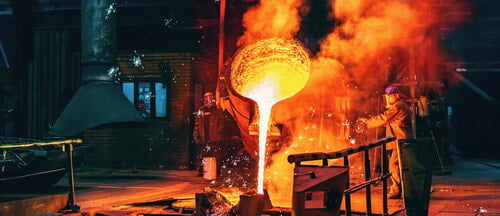Metalwork

Foundries
The human race has been making things from metal since the dawn of time. Records go back to a bull-shaped gold ornament dated to 9,000 BC. Throughout the centuries, we went through several stages, from the Copper age, the Bronze age, and the Iron age. People used metal to make tools, bowls, pipes, skillets, manhole covers, and weapons.
From the Industrial age – from the 18th Century and on, the demand for machined parts was high, and metal casting was invented. The four types of foundries we have today include:
- Steel foundries.
- Iron foundries.
- Non-ferrous foundries.
- Non-ferrrous metal die-casting foundries.
Ferrous Metals
Ferrous metals contain iron, while non-ferrous metals do not. Ferrous metals include iron, steel and grey iron. Common products made from iron include machine tool frames, engine blocks, pumps, pipe fittings, and valves. Common products made from steel include parts used in the aerospace industry, medical equipment, rifles, guns and high-impact wear products.
Non-Ferrous Metals
Non-ferrous metals do not have iron in them and include silver, gold, platinum, nickel, copper, aluminum, titanium, zinc, and tin. Many products are made from non-ferrous metals, including coins.
How to Cast a Product
The casting process is a complex set of steps. We’ll simplify it here, so you can see where you would need personal protective equipment to protect yourself in the foundry industry.
- The first step is to create a pattern so that you can make a precise replica of the parts and products.
- Next, workers prepare the mold, which is a rigid frame. They pour liquid metal into the mold to make a casting. To form a core, workers insert cores into a mold, which shapes the inside of a casting.
- After the metal is poured into the mold, it cools rather quickly. Once cooled, workers remove the part from the mold, clean it and shot blast it.
- The castings are then heat-treated, and workers remove excess metal. The casting is then polished and inspected.
As you can see from the steps, workers need personal protective equipment to protect their hands, arms and bodies from cuts, punctures, chemicals and hot liquid metal.
Occupations in the Foundry Industry
Some of the occupations in the foundry industry include
- Plastic and metal workers.
- Machine setters, operators, molders, cutting, press-setting, and punching.
- Industrial maintenance workers.
- Inspectors, sorters, testers, weighers and samplers.
- Gridres, lappers, polishers, and buffers.
- Operators for computer-controlled machines.
- Casters.
- Pourers.
- Material movers.
- Production helpers.
- Furnace operators.
- Welders.
- Assemblers.
- Fitters.
- Tool and die makers.
Depending on the occupation, workers may encounter flying metal particles, sharp metal, chemicals, and molten liquid.
Common Foundry Hazards
Workers can minimize injuries from hazards of working in a foundry by wearing the proper personal protective equipment as follows:
- Preparing casting molds can cause abrasions on your hands. Abrasion-resistant gloves keep your hands from becoming scratched and chapped.
- Hot casting can easily cause burns just by being in close proximity to the heat. Workers should wear safety clothing and heat-resistant gloves to protect them from radiant burns.
- Workers who cast metal are exposed to moisture, liquids, and hazardous chemicals, including formaldehyde, benzene, and sulfuric acid. Wearing safety coveralls and chemical-resistant gloves significantly reduces the risk of chemical burns.
- Hot steam can burn your face, hands, and exposed skin. When working around liquid metal and certain presses, you’ll need eye protection, face protection, andgloves to protect your hands.
- Foundries have tons of hazards, including flying molten metal, metal shards, steam, and chemicals that could cause burns, skin irritations, cuts and abrasions. Wearing the proper eyewear protects your eyes from the damage particles and chemicals could do to them.
- Material handlers work with rough metal parts all day. Abrasion-resistant gloves keep your hands from getting scratched up and otherwise damaged by handling parts.
- Hi-vis clothing protects workers in dimly lit factories. Even if the lighting is half-decent, corners might be darker. Material handlers and other co-workers could cause injuries if they don’t see you. Hi-vis clothing allows everyone to see you, even when the lighting isn’t that great. You can also purchase fire-resistant high visibility clothing.
Visit Abolox
When you need personal protective equipment, visit Abolox. We sell to individuals and to companies. You can purchase individual pieces or buy in bulk. Browse through our site for what you need – and if you don’t see it, call the office. We’ll source what you need and get it to you as soon as possible.